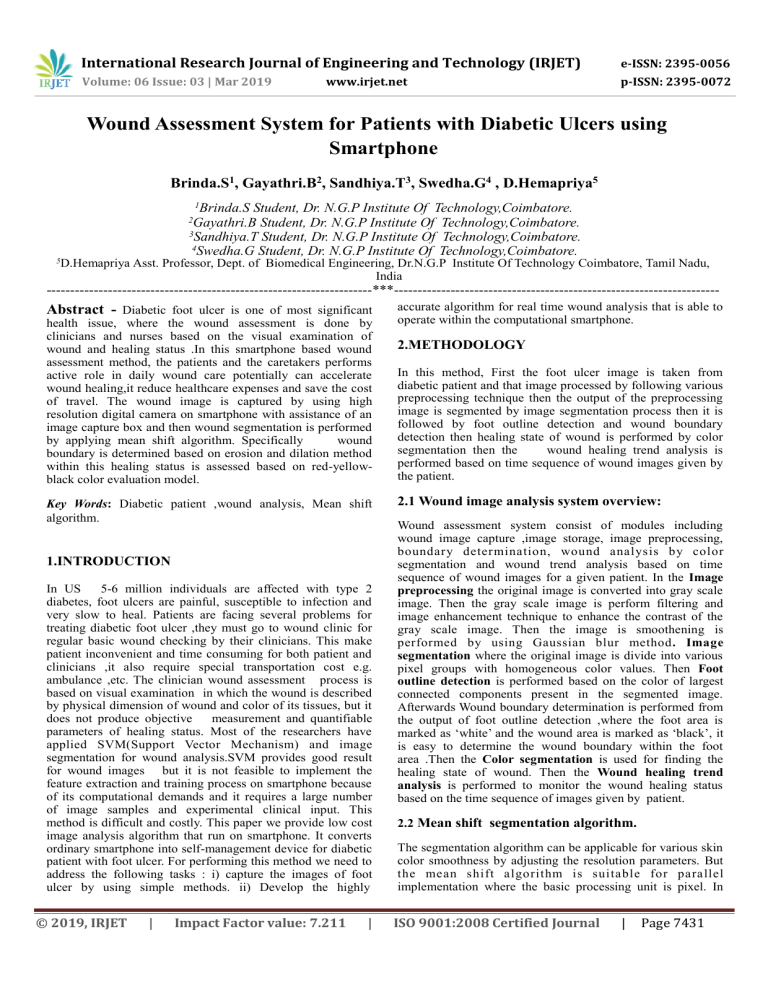IRJET-Wound Assessment System for Patients with Diabetic Ulcers using Smartphone
advertisement

International Research Journal of Engineering and Technology (IRJET) e-ISSN: 2395-0056 Volume: 06 Issue: 03 | Mar 2019 p-ISSN: 2395-0072 www.irjet.net Wound Assessment System for Patients with Diabetic Ulcers using Smartphone Brinda.S1, Gayathri.B2, Sandhiya.T3, Swedha.G4 , D.Hemapriya5 1 Brinda.S Student, Dr. N.G.P Institute Of Technology,Coimbatore. Student, Dr. N.G.P Institute Of Technology,Coimbatore. 3Sandhiya.T Student, Dr. N.G.P Institute Of Technology,Coimbatore. 4Swedha.G Student, Dr. N.G.P Institute Of Technology,Coimbatore. 2Gayathri.B 5D.Hemapriya Asst. Professor, Dept. of Biomedical Engineering, Dr.N.G.P Institute Of Technology Coimbatore, Tamil Nadu, India ---------------------------------------------------------------------***--------------------------------------------------------------------- Abstract - Diabetic foot ulcer is one of most significant health issue, where the wound assessment is done by clinicians and nurses based on the visual examination of wound and healing status .In this smartphone based wound assessment method, the patients and the caretakers performs active role in daily wound care potentially can accelerate wound healing,it reduce healthcare expenses and save the cost of travel. The wound image is captured by using high resolution digital camera on smartphone with assistance of an image capture box and then wound segmentation is performed by applying mean shift algorithm. Specifically wound boundary is determined based on erosion and dilation method within this healing status is assessed based on red-yellowblack color evaluation model. Key Words: Diabetic patient ,wound analysis, Mean shift algorithm. 1.INTRODUCTION In US 5-6 million individuals are affected with type 2 diabetes, foot ulcers are painful, susceptible to infection and very slow to heal. Patients are facing several problems for treating diabetic foot ulcer ,they must go to wound clinic for regular basic wound checking by their clinicians. This make patient inconvenient and time consuming for both patient and clinicians ,it also require special transportation cost e.g. ambulance ,etc. The clinician wound assessment process is based on visual examination in which the wound is described by physical dimension of wound and color of its tissues, but it does not produce objective measurement and quantifiable parameters of healing status. Most of the researchers have applied SVM(Support Vector Mechanism) and image segmentation for wound analysis.SVM provides good result for wound images but it is not feasible to implement the feature extraction and training process on smartphone because of its computational demands and it requires a large number of image samples and experimental clinical input. This method is difficult and costly. This paper we provide low cost image analysis algorithm that run on smartphone. It converts ordinary smartphone into self-management device for diabetic patient with foot ulcer. For performing this method we need to address the following tasks : i) capture the images of foot ulcer by using simple methods. ii) Develop the highly © 2019, IRJET | Impact Factor value: 7.211 | accurate algorithm for real time wound analysis that is able to operate within the computational smartphone. 2.METHODOLOGY In this method, First the foot ulcer image is taken from diabetic patient and that image processed by following various preprocessing technique then the output of the preprocessing image is segmented by image segmentation process then it is followed by foot outline detection and wound boundary detection then healing state of wound is performed by color segmentation then the wound healing trend analysis is performed based on time sequence of wound images given by the patient. 2.1 Wound image analysis system overview: Wound assessment system consist of modules including wound image capture ,image storage, image preprocessing, boundar y deter mi na tio n, wound a na l ys is b y col or segmentation and wound trend analysis based on time sequence of wound images for a given patient. In the Image preprocessing the original image is converted into gray scale image. Then the gray scale image is perform filtering and image enhancement technique to enhance the contrast of the gray scale image. Then the image is smoothening is performed by using Gaussian blur method. Image segmentation where the original image is divide into various pixel groups with homogeneous color values. Then Foot outline detection is performed based on the color of largest connected components present in the segmented image. Afterwards Wound boundary determination is performed from the output of foot outline detection ,where the foot area is marked as „white‟ and the wound area is marked as „black‟, it is easy to determine the wound boundary within the foot area .Then the Color segmentation is used for finding the healing state of wound. Then the Wound healing trend analysis is performed to monitor the wound healing status based on the time sequence of images given by patient. 2.2 Mean shift segmentation algorithm. The segmentation algorithm can be applicable for various skin color smoothness by adjusting the resolution parameters. But t h e me a n s h i ft a l g o ri t hm i s s u i t a b l e fo r p a ra ll e l implementation where the basic processing unit is pixel. In ISO 9001:2008 Certified Journal | Page 7431 International Research Journal of Engineering and Technology (IRJET) e-ISSN: 2395-0056 Volume: 06 Issue: 03 | Mar 2019 p-ISSN: 2395-0072 www.irjet.net this algorithm used for finding density estimation based on non-parametric clustering methods, which used to analyze the feature space like color space, spatial space or the combination of two spaces. In this mean shift algorithm the feature vector is associated with each pixel like color and position of image grid as sample from the unknown probability density function and find the clusters in this distribution. 2.3 Wound boundary determination and analysis algorithm. The mean shift algorithm only segment the original image into various homogeneous regions based on similar features, but the object recognition is needed for accurate wound boundary detection that can be easily understood by the users. The wound boundary detection method has three assumptions. i) The foot image contains little irrelevant background information. ii) The skin on the sole of the foot is nearly uniform color feature. iii) The foot ulcer is cannot be located on the edge of foot outline. The RYB model is one of simple assessment model to evaluate wounds. The red yellow and black or mixed tissues represent the different phases of wound healing process. The red tissue represent inflammatory phase, proliferation or maturation phase. yellow tissues imply infection phase and tissue contains slough. Black tissue imply necrotic tissue phase. Fig-1(a) Input and downsapled image 4. Image Capture Box There are various devices are used for capture the images of diabetic foot ulcer, however these devices have drawbacks like large dimensions ,high cost and most of the devices require Wi-Fi connectivity and laptop or PC for image processing. We design compact ,rugged and inexpensive device called image capture box that allows the patient to view the sole of their foot on the smartphone screen and capture the image of wound. It allows the patient to rest their feet on device comfortably, without requiring any angles of the camera or foot and capture the image of left foot sole as well as right foot sole. We make this device by use of two front surface mirrors placed at the angle of 90 with respect to each other and the common line of contact tilted 45 with respect to horizontal. To provide consistent light for wound image capturing and viewing, the warm white LED lighting is used. 5. Experimental Results The experimental result for the wound images taken from the patient is given as the input of the system fig(a) .The wound boundary determination results with mean shift algorithm shown in figure (b-f). Fig-2,(b) CIE L*A*B COLOUR SPACE 3. GPU based on the optimization: The CPUs are not nearly as powerful as those lapto p or PCs, so that the GPUs are parallelly implemented in most computational demanding modules like androi d based smartphones. The hybrid implementation on both G PUs and CPUs can improve the time efficiency for algorithms. A program may access the following features like d etect the foot region, detect the wound area and color analysis without having to write code. In which the color space transformation, color histogram generation and discretization and weight-map generation steps are implemented on CPU and then all datas are moved to GPU. The parallel implementation of mean shift algorithm copies the image to device and breaks the computation of mode seeking into single pixels and their intermediate surrounding neighboring region. © 2019, IRJET | Impact Factor value: 7.211 | Fig-3,(c) Segmentad Result ISO 9001:2008 Certified Journal | Page 7432 International Research Journal of Engineering and Technology (IRJET) e-ISSN: 2395-0056 Volume: 06 Issue: 03 | Mar 2019 p-ISSN: 2395-0072 www.irjet.net system installed with MATLAB starter application and CPU, GPU application. REFERENCES [1] [2] Fig-4,(d) Mean shift Cluster Result [3] [4] [5] [6] Fig-5,(e) Foot Outline Detection [7] [8] A. Mary Juliet, “Foot Reflexology positions to control Diabetic foot ulcers”, Journal of chemical and pharmaceutical research, Vol. 7, No. 2, 2015, pp. 866-871. C. Toledo , F.J. Ramos , J. Gutierrez, A. Vera2 and L. Leija, “Non-Invasive Imaging Techniques to Assess Diabetic Foot Ulcers: A State of the Art Review”,Health care exchanges, 2014, pp. 1-4. B.Varga, K. Karacs, “High-Resolution Image Segmentation Using Fully Parallel Mean Shift,” EURASIP J. Advances in Signal Processing, vol. 1, no. 111, 2011. K.M. Buckley, L.K. Adelson and J.G. Agazio, “Reducing the risks of wound consultation: Adding digital images to verbal reports,” Wound Ostomy Continence Nurs., vol. 36, no. 2, pp. 163-170, Mar. 2009 Julia Shaw and Patrick M. Bell, “Wound Measurement in Diabetic Foot Ulceration”, United Kingdom, 2011. H. Wannous, Y. Lucas, S. Treuillet, “Combined machine learning with multi-view modeling for robust wound tissue assessment,” Proc. of 5th International Conf. on Computer Vision Theory and Application , pp. 98-104, May. 2010. L. Wang, P.C. Pedersen, D. Strong, B. Tulu, E. Agu, “Smartphone-based wound assessment system for diabetic patients,” presented in 13th Diabetes Technology Meeting, Oct. 2013. Kunjam Nageswara Rao, P srinivasa Rao, Allam Appa Rao, Dr. G R Sridhar, “Sobel Edge Detection Method To Identify And Quantify The Risk Factors For Diabetic Foot Ulcers”, International journal of computer science and information technology, Vol. 5,No.1, 2013, pp.39-46. Fig-6,(f) K means result 3. CONCLUSION We design the wound image analysis algorithm for the patient who suffering type2 diabetes foot ulcer. By using the smartphone camera placed on the image capture box the wound images are captured and then wound analysis algorithm and is implemented by utilizing CPU and GPU. Where the clinicians can remotely analysis the wound results. Hence the wound database of the patient will be constructed on a cloud based server. This is the simplest technique used to determine the wound healing process of type2 diabetes foot ulcer, it comprises of smartphone camera and a computer © 2019, IRJET | Impact Factor value: 7.211 | ISO 9001:2008 Certified Journal | Page 7433

